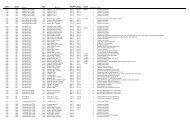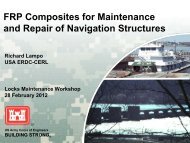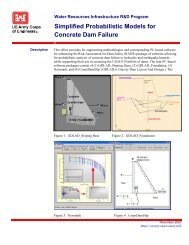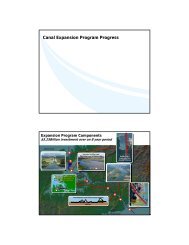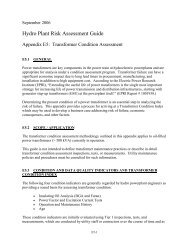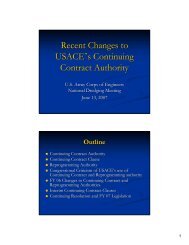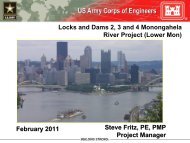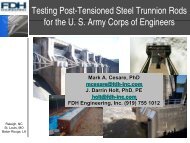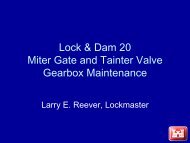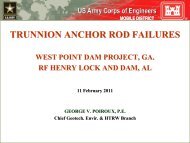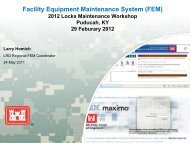Hydro Plant Risk Assessment Guide
Hydro Plant Risk Assessment Guide
Hydro Plant Risk Assessment Guide
You also want an ePaper? Increase the reach of your titles
YUMPU automatically turns print PDFs into web optimized ePapers that Google loves.
Valves – Functional Operation<br />
Test T2.2.4: Valves – Actuation Performance<br />
Valve actuation performance is concerned with the timeframe and smoothness that an emergency<br />
closure valve can operate within. Emergency closure valves typically have some sort of<br />
performance standard stating that the valve must move from the completely open to completely<br />
closed position (usually in a runaway turbine condition) within a certain timeframe (e.g., less<br />
than 2 minutes for Army Corps of Engineers). Obviously, it is not reasonable to perform this<br />
test; however, best efforts should be made to assess the valve actuation performance.<br />
Note: If valve performs unacceptably and the reason relates to the valve operator itself, score a<br />
“No Change” for this section and make an adjustment in the Valves – Operators Performance<br />
section.<br />
Table 20 – Actuation Performance<br />
Results<br />
Acceptable – Valve actuates from fully open to fully closed in the<br />
required timeframe.<br />
Unacceptable – Valve does not actuate from fully open to fully<br />
closed in the required timeframe. Performance based on some<br />
deficiency of the valve assembly.<br />
Adjustment to<br />
Condition Index Score<br />
No Change<br />
Subtract 1.0<br />
Test T2.2.5: Valves – Seals, Sealing Surfaces, and Packing<br />
Valve seals that seal the penstock can either be made of a resilient (i.e. rubber or nylon) or metal<br />
such as stainless steel or bronze. As with gates, some leakage is not necessarily indicative of a<br />
defective seal, but valves usually leak less since they usually have a smaller seal length than<br />
gates. Excessive leakage can be a sign of damage, wear, maladjustment, fabrication deficiency,<br />
or movement of the valve or valve body. Valve shaft trunnions also have a seal or packing that<br />
can leak for the same reasons. Packing will normally leak at a controlled rate even when new.<br />
Note: If sealing problems are related to bushing or bearing wear or damage, assess a condition<br />
adjustment based on the next section, Valves – Bearings and Bushings, so that the same problem<br />
is not scored twice.<br />
E11-21



